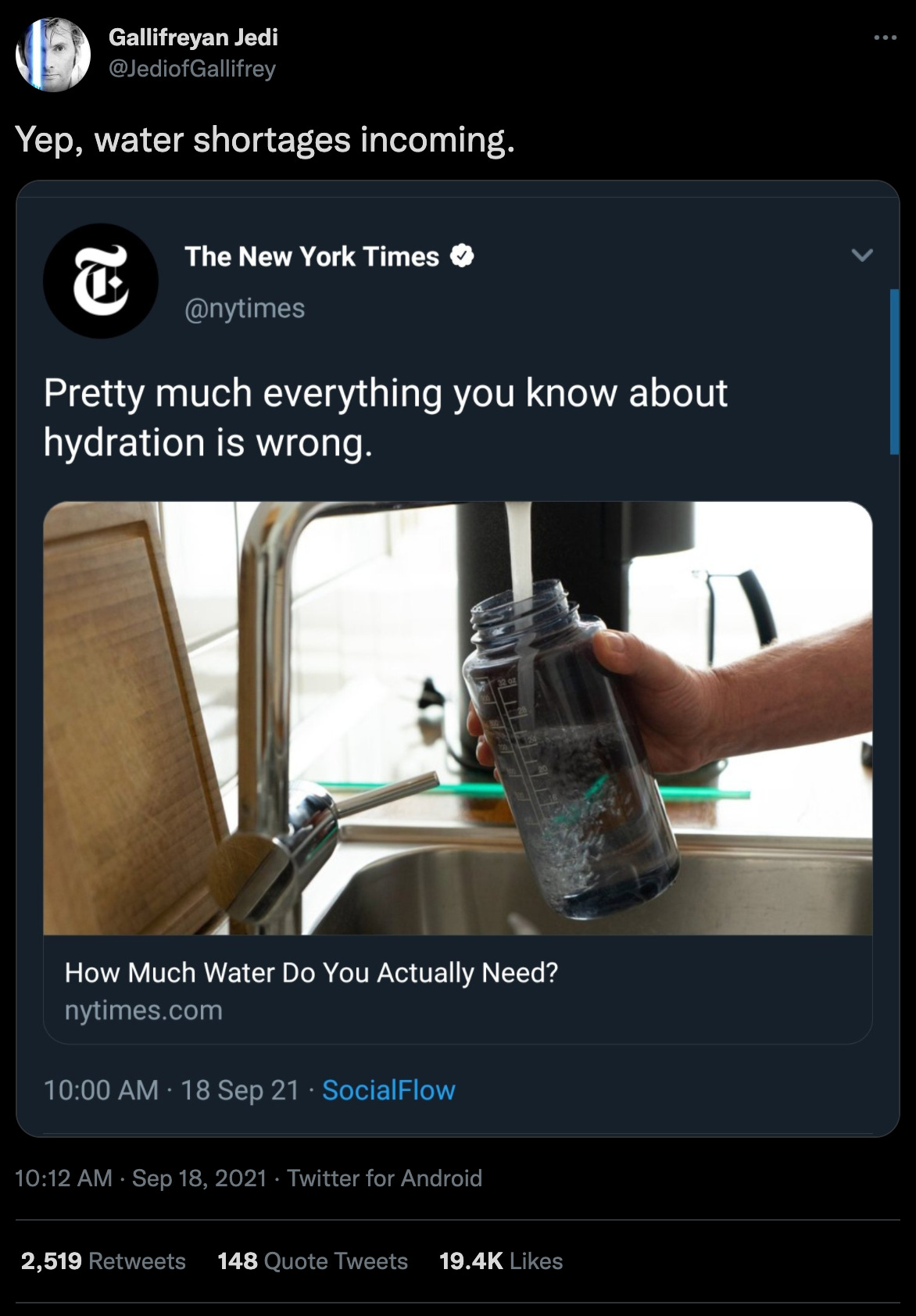Fixing Hydration Disinfo Doesn’t Signal Water Shortages
The "8 glasses a day" mantra was debunked almost twenty ago, and the NYT pushing back against it is not a Mad Max-esque move.
Twitter user @JediofGallifrey quickly went viral today for insisting that a recent New York Times article debunking misconceptions about hydration is, in fact, part of a plot to prepare people for coming water shortages due to climate change. To be clear, some parts of the world are at risk of water shortages if we do not take action. But people think they “know” about hydration is based on since-debunked science that was also misrepresented. This is the sort of shallow, reactionary handling of science that leads people to take horse paste ivermectin for COVID.
Ask most people how much water they should drink a day, and the most common answer you get will probably be “8 glasses,” a concept that seemingly everyone from doctors to athletic coaches to Instagram influencers has internalized as the obvious truth. However, while our Time Lord tweeter acts like pushback against this concept is new, a peer-reviewed meta-analysis of all available evidence from 2002 — almost two decades ago — found no evidence to support what is often dubbed the “8x8 rule.” Instead, it concluded “such large amounts are not needed.” Peer-reviewed research since has only come to similar conclusions.
There is evidence that your body uses approximately 1 mL of water per calorie consumed, which, for a person with a 2,000 calorie diet means approximately 8 cups — a decidedly different unit of measure than glasses, a non-standardized measure equaling anywhere from 1 to 2 cups — and that water can come from anywhere not just drinking straight water. So much of the food we consume every day has more water in it than we might think, so meeting this 8 cup minimum is not particularly tricky.
Some, when discussing this, have talked about how their doctors have told them to drink more water, and how they trust their doctors over the New York Times. Given the article is behind a paywall and the post that went viral was a mere screenshot of the tweet, it is understandable many are not aware that the article itself cites experts following this particular topic closely, such as Dr. Joel Topf, a kidney specialist, and Tamara Hew-Butler, a scientist researching athletics and hydration.
Of course, drinking 8 glasses of water a day certainly will not hurt. Water toxicity is possible but requires an absurd degree of overconsumption. The placebo effect is also certainly a factor: if you expect drinking a lot of water to make you feel better, it is likely to make you feel better. But that does not mean that it is nutritionally required. Doctors also know that patients often are eager to have seemingly productive things to do to take charge of our health, and drinking more water is easy, incredibly benign advice to give.
Twitter routinely discusses how much doctors fatphobically obsess over weight loss, despite the fact that research suggests that most people struggle to permanently keep off weight, especially in the presence of other mental and physical health challenges, making it a largely ineffective target to improve someone’s health. Fat is also often blamed when underlying conditions are present — conditions that are not even looked for when the doctor has an easy way to handwave symptoms away. So much of this goes beyond cruelty and simply represents sort of an “inertia” that happens in science, where those involved in the day-to-day of a field are behind those at the forefront.
The conspiracy theorist argument is that, by getting people to drink less water, rich people will be able to justify their opulent ornamental gardens. But drinking water directly is such a drop in the bucket — pun intended — of our water consumption. The average American is responsible, much of it indirectly, for the use of approximately 22,000 gallons of water a day, a lot of which comes from water-intensive agriculture that keeps us fed. If we define a “glass” generously as two cups, that means 8 glasses represents a single gallon of consumption a day. If you’re concerned about saving water, asking people to drink less would be hilariously ineffective.
A standard toilet flush is 1.6 gallons, and “ultra-low flow” toilets typically only get that number down to around 1.3 — and the average person flushes a toilet 5-6 times per day! Surely if they were desperate to eek out such gains in water consumption, it would make far more sense to insist, as my hippie aunt has had a sign up in her bathroom saying for decades, “If it’s yellow, let it mellow.” Here at Smol Farm, we are lucky to have toilets that have an option to use a half-tank to flush urine, but even that uses more than a half-gallon each time.
Climate change is terrifying and water shortages will be created. But we should not stoke the terror even further with anti-science reactionaryism. By making people worry that there must be a looming, widespread water shortage in the very near future, you just play into doomerist mindsets about climate. When people feel hopeless, the results are often worse than not believing in climate change at all. Instead of treating the water problems we are facing with the seriousness they deserve, this turns it into counter-productive alarmist clout-chasing that benefits no one.


